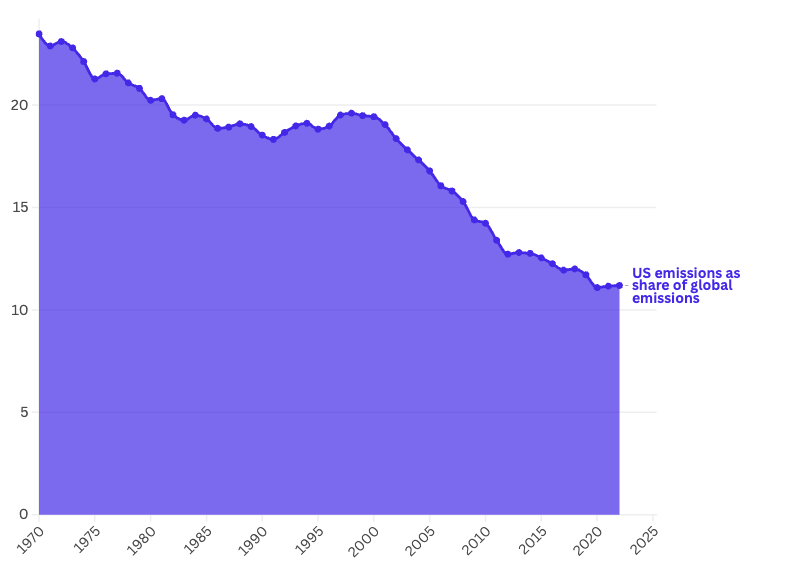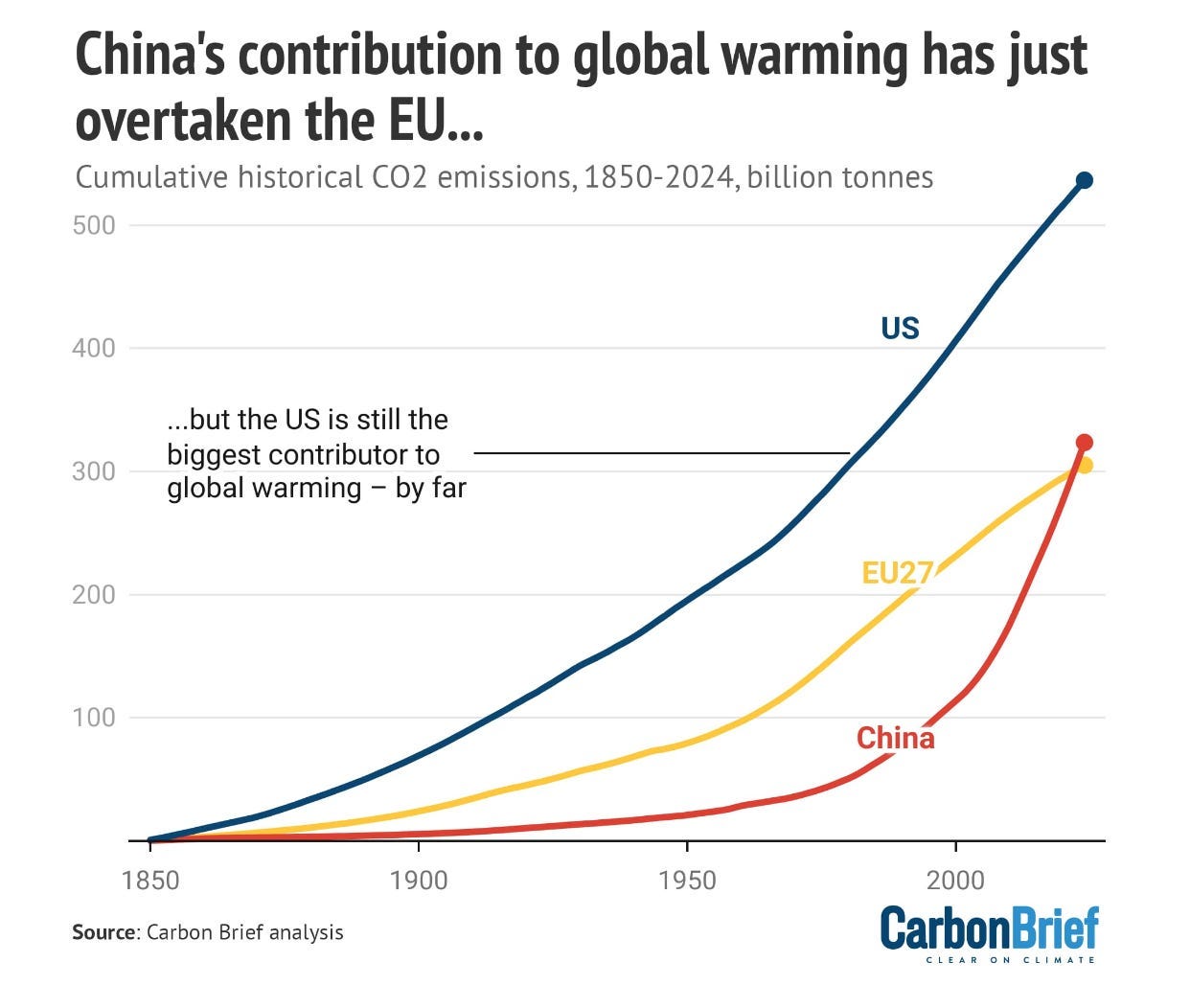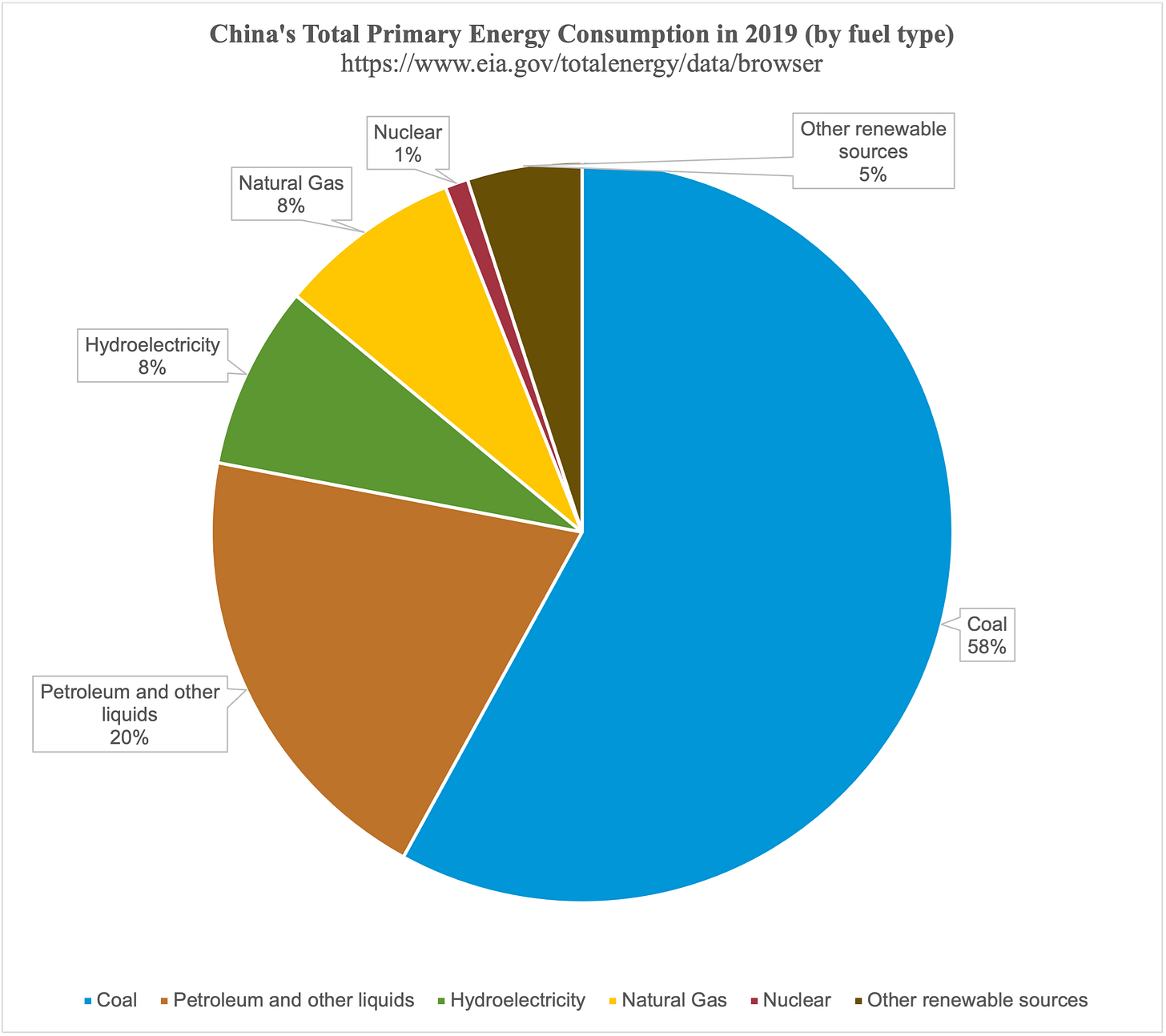Why Greens should stop focusing on the West
It is as simple as ABC - All 'Bout China (and the rest of Asia).
It Is Not About the West
For the past 40 years, Green energy policies have focused on wealthy Western nations. The current consensus among climate activists as to how to fight climate change emerged in the 1980s: the West should decarbonize by rapidly replacing fossil fuels with solar, wind, and other renewables. The argument went that this would give room for developing countries to grow economically using fossil fuels and later transition to renewables when they become rich enough to do so.
Back in the 1980s and early 1990s, this idea made some sense. Global carbon emissions in 1990 were 22.75 trillion tons. In that year the United States, Canada, Europe, and Japan emitted the majority of carbon emissions. In such a world, an exclusive focus on wealthy nations made some sense (Global Carbon Project 2021).
The United Nations Framework Convention on Climate Change in 1992 and the subsequent Kyoto Protocol of 1997 were built on this political consensus. By the time of the Copenhagen Accord of 2009, however, the assumptions behind this political consensus had collapsed. No one, least of all the climate activists, foresaw what was to come in the three decades after 1990.
The entire geography of carbon emissions has radically shifted from wealthy Western nations to developing nations in Asia, particularly China, India, and Indonesia. Yet Green rhetoric has not adapted to this massive change.
Most of the following is an excerpt from my second book Promoting Progress: A Radical New Agenda to Create Abundance for All. You can order e-books at a discounted price at my website, or you can purchase full-price ebooks, paperback, or hardcovers on Amazon.
Other books in my “From Poverty to Progress” book series:
See also my other articles on Energy:
Why Greens should stop focusing on the West (this article)
Transition from Coal, Not Fossil Fuels
Once you cut through all the ideology and all the doomsday rhetoric, we can identify practical solutions that lower global carbon emissions faster than Green proposals without endangering world economic growth.
The big problem with air pollution and carbon emissions is not fossil fuels in general, but more specifically coal. One area where I agree with environmentalists is the dangers of coal. Wherever there are no huge cost disparities between coal and petroleum, natural gas, nuclear, or hydroelectric, I would avoid coal if possible.
Note that the above graphic actually greatly underestimates the reduction in carbon dioxide emissions by using natural gas. It lumps together very energy-efficient Combined Cycle Gas Turbines (CCGT) with much less energy-efficient natural gas Simple Cycle peakers. New CCGT plants reduce carbon emissions by about two-thirds compared to existing coal plants.
Coal is the worst carbon emitter (apart from wood) and by far the worst air and water polluter. Ending the use of coal is a very realistic goal in many nations, as long as they do not try to do so exclusively with solar and wind.
Unfortunately, coal is currently the cheapest form of energy in many regions. This is exactly why developing nations have built so many coal plants. Wealthy nations need a better alternative to coal than pushing solar and wind.
Since we are on the topic of coal use, I should mention China, India, and Indonesia. China alone consumes more than half of all coal burned in the world. India and Indonesia are second and third on the list. Together these three nations consume two-thirds of all coal used in the world. Unfortunately, environmentalists ignore this crucial fact (Global Energy Monitor).
If the goal is to reduce global carbon emissions as fast as possible without endangering economic growth in developing nations, it is far more cost-effective to transition those three nations from coal to a blend of natural gas, nuclear and hydroelectric power than for the West to install solar and wind. If those three nations can make the transition, then it will be easier for all the other developing nations to do so as well.
ABC… It Is All Bout China (and the rest of Asia)
Rather than focusing on wealthy Western nations, those who want to reduce carbon emissions need to think globally. Climate emissions are no longer a Western problem. Now carbon emissions are mainly an Asian problem.
Between 1990 and 2020 the geographical distribution of carbon emissions changed radically. Now China alone emits more carbon than North America, the European Union, and Japan combined. In those 30 years, China increased its annual carbon emissions by 381%, while India increased its emissions by 302.7% (Global Carbon Project 2021).
In 2020, China alone emitted 30% of world carbon emissions, by far the highest of any nation. India is now the third leading carbon emitter. Even worse, for future emissions, a bevy of Asian nations are rapidly increasing their emissions as well. In 2020, Asia made up a full 53% of all global carbon emissions, and there is every reason to expect this share to grow in the future (Global Carbon Project 2021).
And just recently cumulative carbon dioxide emissions by China over the last 174 years has surpassed the entire EU and is closing in on the USA.
Greens and the Left in general have not integrated this fundamental geographical change into their worldview. They still behave as if carbon emissions are concentrated in rich Western nations, and so they assume that is where the biggest reductions are needed.
Quite frankly, if you do not have a climate change solution that involves China and the rest of Asia, then you do not have a workable solution at all. And the Greens do not have a solution that involves China and the rest of Asia. China and the rest of Asia have essentially ignored climate change while pretending to care.
We have reached a point where the future trend of Western emissions does not matter very much. Their carbon emissions will decline regardless of public policy. Going forward, it is all about China and the rest of Asia.
ABC… It Is All Bout Coal (in China)
What caused this enormous increase in carbon emissions in China and the rest of Asia? It was overwhelmingly the construction of coal-burning power plants. While it is clear that this trend is bad for the natural environment, it is important to understand why so many Asian nations are turning to coal for their primary energy needs.
Why did so many Asian nations construct coal-burning power plants? There are four reasons:
Abundant, affordable, and secure energy is essential for long-term economic growth.
The leaders of Asian nations want their economies to grow to maintain public support and national security, and increase their influence in the world.
Most Asian nations have substantial domestic coal fields. This coal can be burned to create abundant, affordable, and secure electricity. Coal can also be combusted directly in their economically critical export industries.
Most Asian nations have no other energy source that can offer all the benefits of coal.
As long as these four factors remain in effect, Asian nations will continue to construct coal-burning power plants. The effects of this trend dwarf any countervailing trends in rich Western nations.
With a few exceptions, developing nations have chosen coal as their primary energy source. China is the premier example of this trend. Between 2000 and 2021 China built 1,011 GW (gigawatts) of coal power plants. This made up 81.6% of all new power plants constructed in the entire world!
For comparison, a very large coal plant puts out about 1 GW of electricity, and all coal plants in the United States together put out 217.8 GW. This is barely 20% of the capacity that China constructed in just 20 years. So, in 20 years, China constructed five times the amount of coal plants that currently exist in the United States (Global Power Plant Tracker by End Coal)!
While China has been the global leader in the construction of coal-burning power plants, it was not alone. Other Asia countries also constructed a large number of coal power plants. Between 2000 and 2021, India added 188.6 GW, while Indonesia added 34 GW. Other Asian countries such as Japan (26.3 GW), South Korea (28.2 GW), and Vietnam (22.8 GW) also built substantial numbers of coal plants. In total, over 90% of all new power plants constructed over the last thirty years were in Asia (Global Power Plant Tracker by End Coal).
And there is no sign that this trend will stop. As of July 2022, China has officially announced, pre-permitted, permitted, or is in the middle of construction of coal plants that will emit an estimated 44,000 million tons of carbon dioxide over their lifetime. When one adds in similar plants in the rest of the world, the estimate comes to 74,000 tons of total future carbon emissions (Global Power Plant Tracker by End Coal).
Meanwhile, carbon emissions in the United States and European emissions declined by almost 20%. Europe started reducing carbon emissions in the 1980s when they started decommissioning older coal plants in favor of nuclear and natural gas. The United States did the same starting around 2006 with the Shale Revolution. These reductions of carbon emissions are largely due to the Third Energy Transition involving natural gas, nuclear, and hydroelectric power.
One might think that climate activists would rapidly update their rhetoric and proposed policies to shift from the western nations to Asia, particularly China. Nothing of the sort happened. Virtually all the political focus of climate activists has been on the United States (15% of global emissions) and the EU (10% of global emissions). So, while Asia emits more than double the amount of carbon of the USA and EU combined, Asia get very little political attention.
At best, climate change activists claim that solar and wind are cheaper than coal, so it is short-sighted of Asia to continue building coal plants. As we shall see, this is a very dubious assumption.
Regardless of whether I am right, China, India, Indonesia, and the rest of Asia apparently agree with me as they are rapidly building coal-burning power plants. Though this trend has slowed substantially, there is no widespread move to decommission coal plants in favor of wind/solar in Asia.
Given that China alone has carbon emissions greater than the United States, Canada, and the European Union combined, attempts to lower global carbon emissions with renewable energy in the West are like Don Quixote tilting at windmills. They are not even focused on the location of the real problem, which is in Asia.
So what is your proposal?
Any movement that is aiming for global Netzero in 2050 must have a proposal for how to decommission coal-burning power plants in China, India, and the rest of Asia without disrupting their economic growth. Given the enormity of their present and future carbon emission, to not have one is disingenuous. And to be successful, the proposal must be in the economic self-interest of those nations to follow the proposal. Here is my proposal.
If you do not have a plan for Asian coal, then you do not have a plan!
Most of the above is an excerpt from my second book Promoting Progress: A Radical New Agenda to Create Abundance for All. You can order e-books at a discounted price at my website, or you can purchase full-price ebooks, paperback, or hardcovers on Amazon.
Other books in my “From Poverty to Progress” book series:
See also my other posts on Energy:
Why Greens should stop focusing on the West (this article)

















Curious too about the scrubbers installations in China on coal plants
Excellent work at explaining the obvious. Unless you're talking about China, you're not being serious.